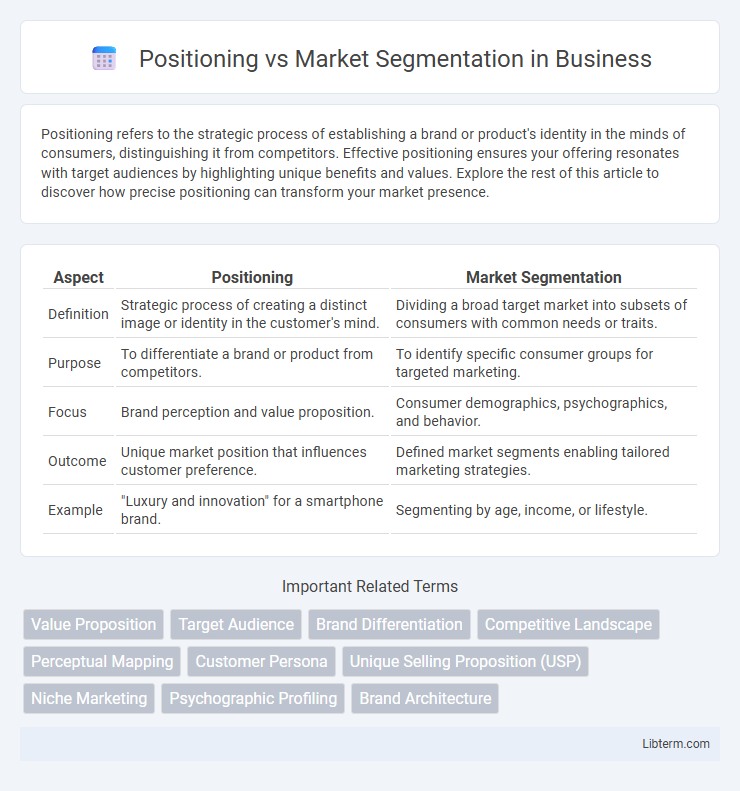Positioning refers to the strategic process of establishing a brand or product's identity in the minds of consumers, distinguishing it from competitors. Effective positioning ensures your offering resonates with target audiences by highlighting unique benefits and values. Explore the rest of this article to discover how precise positioning can transform your market presence.
Table of Comparison
| Aspect | Positioning | Market Segmentation |
|---|---|---|
| Definition | Strategic process of creating a distinct image or identity in the customer's mind. | Dividing a broad target market into subsets of consumers with common needs or traits. |
| Purpose | To differentiate a brand or product from competitors. | To identify specific consumer groups for targeted marketing. |
| Focus | Brand perception and value proposition. | Consumer demographics, psychographics, and behavior. |
| Outcome | Unique market position that influences customer preference. | Defined market segments enabling tailored marketing strategies. |
| Example | "Luxury and innovation" for a smartphone brand. | Segmenting by age, income, or lifestyle. |
Understanding Positioning: Definition and Importance
Positioning refers to the strategic process of creating a distinct image or identity for a brand, product, or service in the consumer's mind relative to competitors. It is crucial for differentiating offerings in a crowded market, influencing customer perception, and driving brand loyalty. Effective positioning leverages unique value propositions and target audience insights to establish a competitive advantage and enhance market relevance.
What is Market Segmentation?
Market segmentation is the process of dividing a broad consumer or business market into sub-groups of consumers based on shared characteristics such as demographics, psychographics, geographic location, or behavior. This strategic approach enables companies to target specific segments with tailored marketing efforts, improving relevance and engagement. Effective market segmentation allows businesses to allocate resources efficiently and create customized value propositions for diverse customer needs.
Key Differences Between Positioning and Segmentation
Market segmentation divides a broad consumer or business market into sub-groups based on shared characteristics such as demographics, behavior, or needs, enabling targeted marketing strategies. Positioning focuses on crafting a distinct brand image and value proposition in the minds of the target segment to differentiate from competitors. While segmentation identifies who the customers are, positioning defines how the product or brand is perceived relative to competitors within that segment.
The Role of Positioning in Marketing Strategy
Positioning defines how a product is perceived relative to competitors in the target market, shaping consumer preferences and brand identity. It aligns marketing messages and product attributes with specific customer needs identified through market segmentation. Effective positioning drives competitive advantage by creating a unique value proposition that resonates deeply within selected market segments.
The Process of Effective Market Segmentation
Effective market segmentation involves identifying distinct groups within a broader market based on shared characteristics such as demographics, psychographics, geographic location, and behavior patterns. This process enables businesses to tailor marketing strategies and product offerings to meet the specific needs of each segment, increasing customer relevance and engagement. Precise segmentation facilitates targeted communication, resource optimization, and improved competitive advantage by aligning marketing efforts with segmented consumer demands.
How Positioning Influences Customer Perception
Positioning shapes customer perception by creating a distinct image and identity for a brand or product in the consumer's mind, emphasizing unique benefits and value propositions that differentiate it from competitors. Effective positioning leverages brand messaging, visual elements, and customer experiences to align with target market needs, fostering strong emotional connections and brand loyalty. Market segmentation identifies specific groups of consumers, but positioning directly influences how these segments perceive and relate to the brand's offerings.
Aligning Segmentation with Business Goals
Aligning market segmentation with business goals ensures targeted strategies that maximize customer value and drive competitive advantage. Effective positioning depends on selecting segments that align with the company's strengths, resources, and long-term objectives. Clear alignment enhances marketing efficiency, customer engagement, and overall business performance.
Positioning Strategies for Competitive Advantage
Positioning strategies involve creating a distinct image or identity for a brand or product in the minds of the target market, emphasizing unique value propositions that differentiate from competitors. Effective positioning leverages factors such as quality, price, usage, or target audience to establish a competitive edge and foster customer loyalty. Market segmentation identifies specific consumer groups, while positioning tailors messaging to resonate deeply with those segments, driving stronger market presence and profitability.
Common Mistakes in Segmentation and Positioning
Common mistakes in market segmentation include using overly broad or vague criteria, which leads to ineffective targeting and wasted marketing resources. Positioning errors often stem from failing to clearly differentiate the brand from competitors or misunderstanding the target segment's needs and preferences. Mixing demographic segments without behavioral insights can result in weak positioning strategies and poor customer resonance.
Integrating Positioning and Segmentation for Market Success
Integrating positioning and market segmentation involves aligning targeted customer groups with unique value propositions to enhance brand relevance and competitive advantage. Effective segmentation identifies distinct consumer needs, while precise positioning communicates tailored benefits that resonate with each segment, driving higher engagement and loyalty. This strategic fusion ensures resource optimization and maximizes market impact by delivering differentiated offerings that meet specific demands.
Positioning Infographic

 libterm.com
libterm.com